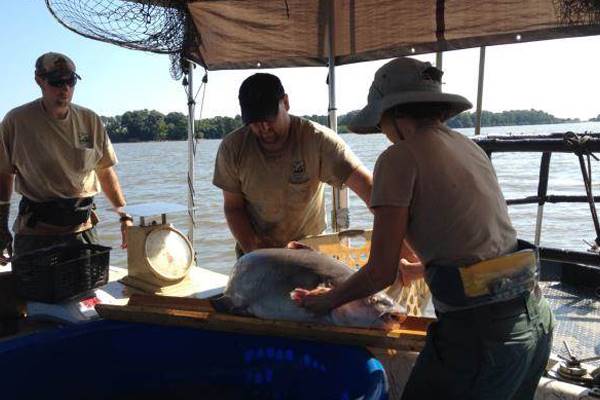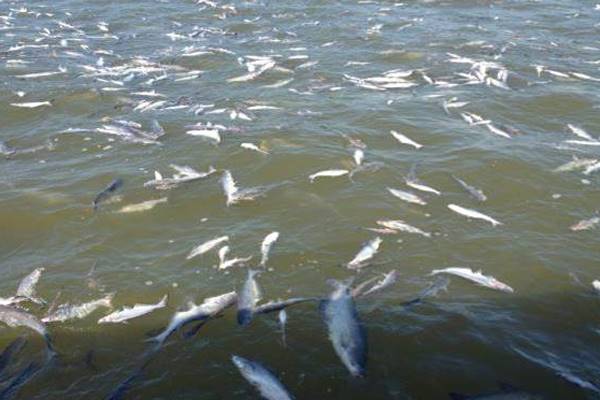Popular Virginia blue catfish fishery complicates Chesapeake Bay restoration
Virginia’s popular introduced blue catfish fishery is something that both trophy- and food-seeking anglers can get excited about. But the health of the Chesapeake Bay ecosystem might be better off if there weren’t quite so many of them around.
“Anglers love them. They provide important economic value to the region,” said Aaron Bunch, tidal rivers project leader with Virginia Department of Game and Inland Fisheries. “However, there are potential impacts to other important Chesapeake Bay resources.”
Blue catfish were introduced into Virginia waters in the 1970s as a new target for anglers, who took to the fish’s mild, sweet flavor and tremendous potential size. While sampling blue catfish for state surveys, Bunch said he commonly sees fish in the 30- to 50-pound range in the James River, and last year encountered an 87-pounder Mattaponi River. A 102-pound blue caught in the James River in 2009 stood as the state record for the species until it was unseated in 2011 by a mind-boggling 143-pound fish caught in an inland reservoir. That one also stands as the current International Game Fish Association’s world-record blue catfish.

A crew measures a blue catfish during a fish survey. (Credit: Virginia Department of Game & Inland Fisheries/CC BY 2.0)
Besides producing large fish, the populations have since skyrocketed in the state’s tidal rivers. Blue catfish make up as much as 75 percent of total fish biomass in the James and Rappahannock Rivers in Virginia, according to the National Oceanic and Atmospheric Administration’s Chesapeake Bay office.
After years of quickly growing populations, the species’ soaring abundance appears to be leveling off and settling into an equilibrium across Virginia’s rivers, Bunch said. Growth rates are falling as well, and the state’s famous catfisheries aren’t producing as many large fish as they once did.
“The James River used to be characterized as a trophy catfishery, and it still is. But there are fewer larger individuals than there were, say, in the 2000s,” Bunch said. “Other rivers have shifted completely to a much smaller-sized fish.”
Though the number of catfish may not be climbing as quickly as it was, there are still enough of them throughout the Chesapeake Bay’s tributaries — include those in Maryland — for the bay’s watchers to be concerned about the effects on native species. A 2013 study from Virginia Commonwealth University found blue and flathead catfish were eating juvenile Atlantic menhaden, American shad, white perch, American eel, spot, blue crab and softshell clam — all economically important species. The losses could be especially significant to shad and herring, migratory species that are in decline along the coast.

Stunned blue catfish in a Virginia River come to the surface during electrofishing survey. (Credit: Virginia Department of Game & Inland Fisheries)
The Chesapeake Bay Program, a regional partnership that directs restoration and protection, has even adopted an Invasive Catfish Policy that says “the potential risk posed by blue catfish and flathead catfish on native species warrants action to examine potential measures to reduce densities and limit range expansion, and to evaluate possible negative ecological impacts.”
The plan is to pursue those density-reducing goals while “keeping in mind” the catfish’s recreational and economic value, according to NOAA. That means eradication isn’t part of the scheme, though it wouldn’t likely be possible anyway, Bunch said. There are other options, however. The Maryland Department of Natural Resources, for example, is encouraging anglers to keep any flathead or blue catfish they catch.
In Virginia, scientists are doing more to learn about the blue catfish population there and how it interacts with the wider ecosystem. The Department of Game and Inland Fisheries monitors catfish every year with slow, low-pulse electrofishing methods. They try to hit every river at least every other year to monitor age, growth and population trends, and gather about 1,500 otolith bones for those analyses a year. They’re also funding a study with Virginia Tech looking at trophic interactions and population modeling to understand impacts of blue catfish on the overall ecosystem.

0 comments